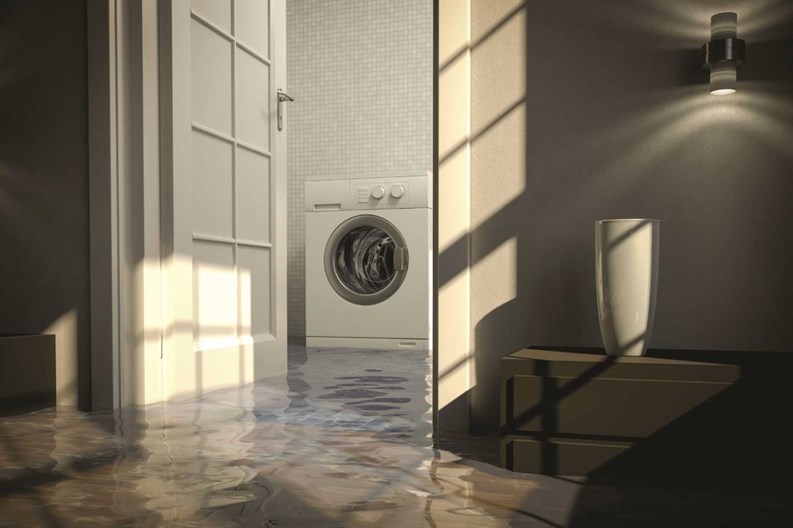When is a flood not a flood? That’s a serious question for the Garden State's residential communities. Even if they have flood insurance, damage caused by heavy rains and backed-up sewers may not meet the National Flood Insurance Program (NFIP) definition of a flood—and that can mean financial devastation for condo, HOA and co-op owners, who thought they were fully covered.
“Flood insurance covers direct physical losses by flood and losses resulting from flood-related erosion caused by heavy or prolonged rain, coastal storm surge, snow melt, blocked storm drainage systems, levee dam failure, or other similar causes,” says Loretta Worters, vice president of communications at the Insurance Information Institute (I.I.I.), a non-profit trade association sponsored by the property-casualty insurance industry. “To be considered a flood, waters must cover at least two acres or affect two properties.”
According to Charles “Cappy” Stults, president of Allen & Stults Co. Inc., an insurance brokerage based in Hightstown, the filing of a flood insurance claim is not much different than filing any other property claim. The information required is essentially the same. “If with a private insurer versus the National Flood Insurance Program (or NFIP), the coverage is simply an added ‘peril,’ he says. “Flood being added to perils of fire, wind, explosion and the like. Keeping track of expenses to protect the property from further damage, the cost of mitigation to reduce the size of the loss and estimates to repair or replace the damaged property are all needed for the claim adjustment.”
“Once an insurance claim is reported, an adjuster is assigned. He or she will go to the site and review the damage and determine what the cause was and whether it was caused by a covered cause of loss under the policy, what was damaged and the estimated cost of repairs,” says Edward J. Mackoul, CIC, president of Mackoul & Associates Inc., an insurance brokerage in Old Bridge. “It is always a good idea for the insured to take pictures so they have a record of what was damaged. In the case of Sandy, a lot of associations had to show proof that there was damage—say an air conditioner unit showing a water line on it—so it’s good to have something to fall back on in the case of a discrepancy.”
Hurricane Sandy
In 2012, Hurricane Sandy hit the East Coast, and its effects in New Jersey were devastating, with economic losses to businesses estimated to be as much as $30 billion. The massive storm made landfall on October 29th, leaving over 2 million households in the region without power, 346,000 homes damaged or destroyed, and 37 people dead.
Mandatory evacuations occurred up and down the Jersey Shore and the barrier islands. However, when the storm dissipated on October 31 moving up into Canada, New Jersey and much of the tri-state coastal region was left in shambles. According to Governor Chris Christie, cleaning up New Jersey after Superstorm Sandy would cost the state roughly $36.8 billion. An analysis of aerial imagery conducted by the Federal Emergency Management Agency (FEMA) indicated that approximately 72,000 homes and businesses in New Jersey were damaged or destroyed by the storm.
Where Flooding Happens
As one might expect, flooding in New Jersey occurs primarily along the coast. During Superstorm Sandy, Monmouth and Ocean counties and the seaside communities on Long Beach Island were amongst the hardest hit.
“Floods can occur anywhere—even miles from any ocean, river or body of water,” warns Stults. “Flood includes the sudden and rapid accumulation of surface water, as well as that which may back up from storm drains. A six-inch rain in one hour can occur on a hilltop, and if the storm drains can’t handle it, a general condition of flooding can occur. For those areas not designated by the NFIP as flood-prone areas, businesses—including condo/homeowners associations—can generally get flood as an 'added peril' to their master property insurance. Unit owners generally do not have the availability of private flood insurance except in some cases as ‘excess’ over the maximum available through the NFIP.”
To find out what zone your property is in, visit the FEMA Map Service Center at www.msc.fema.gov and type in your address. Be forewarned, however; the website can be cumbersome, and takes some patience to navigate.
Why NFIP?
After several disastrous Mississippi River floods led most private-sector insurance companies to abandon flood coverage, Congress created the National Flood Insurance Program in 1968. Today NFIP is part of FEMA, which in turn is part of the Department of Homeland Security.
The NFIP provides insurance coverage to 5.5 million properties in flood-prone regions throughout the U.S. In an average year, the program is supposed to take in enough money to cover its flood claims, but major disasters—including Hurricane Katrina in 2005 and Superstorm Sandy in 2012—have left the NFIP $25 billion in debt to the U.S. Treasury.
Two years ago, Congress passed the Biggert-Waters Flood Insurance Reform Act of 2012 (BW-12), which would have increased premiums in four annual giant steps to reach an actuarially-sound level. Single-family homes began to be affected in 2013. New maps going into effect in the next few years will place some residential communities into a special flood hazard zone with a much higher premium.
When affected individuals and groups realized the impact the BW-12-mandated premium increases would have, they complained to their congressional representatives. The lawmakers responded by enacting the Homeowner Flood Insurance Affordability Act of 2013, which President Barack Obama signed into law on March 24, 2014. By repealing the most onerous provisions of BW-12, the new law will slow the rise in premiums, giving property-owners more time to adjust while delaying the attainment of full actuarial soundness.
Condos, Co-ops, and HOAs
If your condominium is in a special flood hazard area, your board has a fiduciary obligation to buy flood insurance on the structure, and also on the contents of the common areas such as offices, meeting rooms, and game rooms. Elsewhere, it isn’t a bad idea. According to Worters, twenty-five percent of all NFIP flood claims are for homes outside of high-risk zones.
In a cooperative, a corporation owns the buildings and land, while the stockholders have a proprietary lease on their living quarters. The bylaws should specify the corporation’s responsibility to insure the building.
Condos and co-ops buy a Residential Condominium Building Association Policy (RCBAP). Individual condo owners and co-op shareholders may buy flood insurance for their own furniture, fixtures, equipment, and any additions or alterations they make at their own expense to the interior of their own condo or leased co-op unit.
Lenders may require individual owners on upper floors to buy flood insurance, but it shouldn’t cost very much. While upper floors may remain habitable after a flood, plumbing and electrical panels and wiring might suffer severe damage, necessitating their replacement several floors above the level of the flood.
And if premiums rise, some condo associations and co-op corporations may consider dropping flood insurance entirely.
“Homeowner’s mortgage companies require as part of the loan, that either the owner or the association maintain adequate flood coverage when the condominium is located in a high-risk flood zone,” says Mackoul. “If the condominium association does not maintain flood coverage or does not maintain an adequate amount, then the owner’s mortgage company will force place a flood policy for the owner to protect their (the mortgage company’s) interest.”
Limits and Excess
In a residential co-op with more than five units, the maximum amount of NFIP coverage previously available was $250,000 on the building and another $250,000 on the contents of the common areas. On June 1, 2014, those limits increased to $500,000.
Condos have their own set of rules. The limit available from the NFIP is at least 80 percent of the full replacement cost, or $250,000 per unit, whichever is less. Thus, a 10-unit condo could buy up to $2.5 million from NFIP.
“I think it's a bad idea not to have flood insurance,” says Ryan Fleming, vice president of JGS Insurance in Holmdel. “In my business we are advising clientele to prepare for the worst catastrophe. Saving money in the form of flood premiums is not the best way to prepare for that catastrophe.”
“Flooding cannot be stopped. Housekeeping and alarms can greatly reduce the likelihood of fire but nobody has yet figured out how to stop six inches of rainfalls and hurricanes,” says Stults. “When it starts it can’t be stopped until it has run its course.”
Christy Smith-Sloman is a staff writer with the New Jersey Cooperator. George Leposky, a Florida-based freelance writer and editor, contributed to this article.







Comments
Leave a Comment